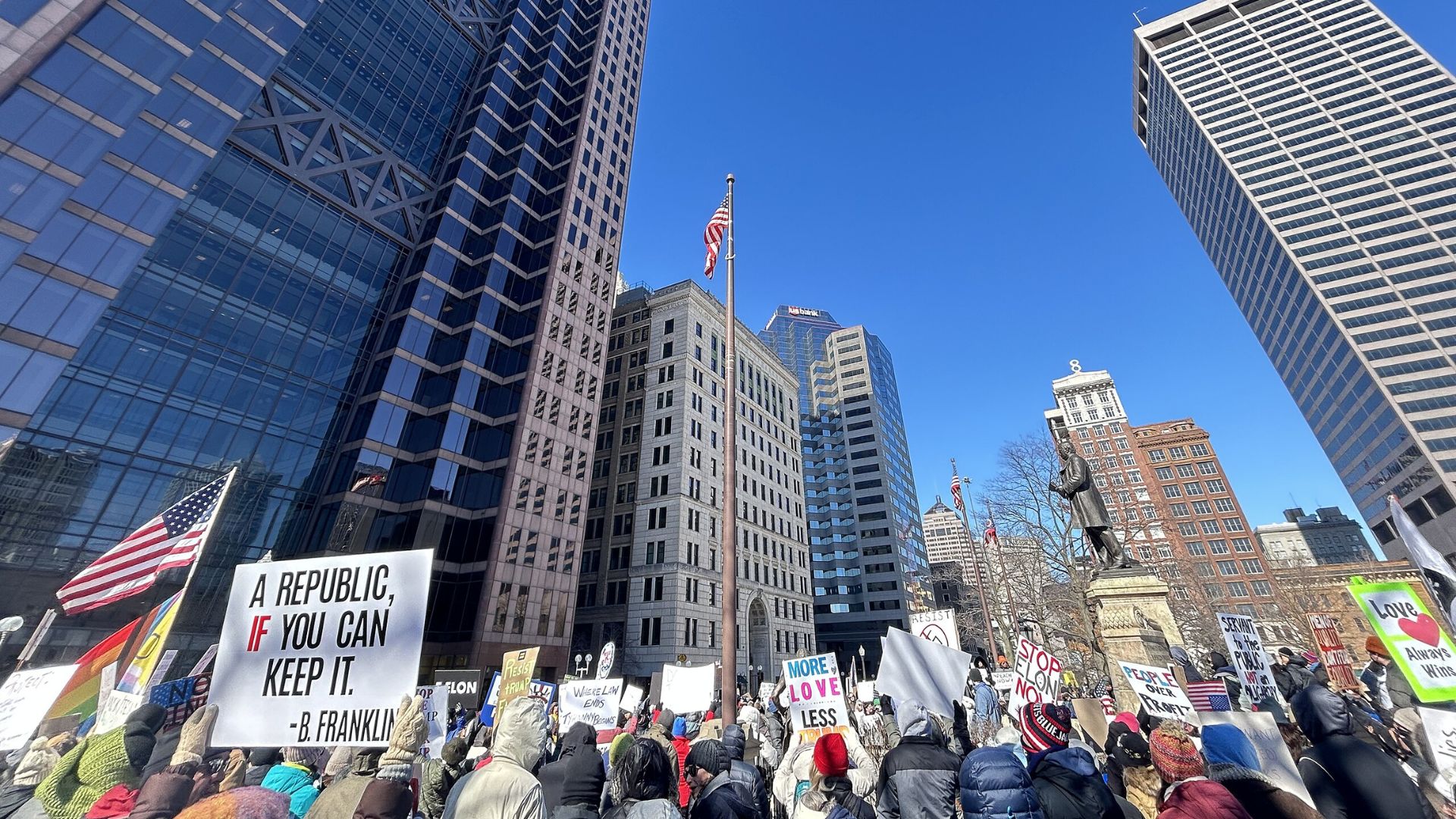The previous Strike! Commentary, “Social Self-Defense: A Strategic Assessment,” proposed “social self-defense” as a framework for the burgeoning resistance to the MAGA assault on society. It proposed that the forces resisting MAGA establish themselves as a “movement-based opposition.” This and subsequent commentaries lay out ways to implement that strategy.

Hands Off rally, National Day of Action, Saturday April 5, 2025. Rally by the Washington Monument in Washington, DC. Rally photo credit: Wikimedia Commons, G. Edward Johnson, CC by 4.0. Donald Trump’s photo credit: Public Domain.
Resistance to the second Trump regime was slow to start but is now emerging in myriad forms. They range from communities organizing to protect immigrants, trans kids, and political dissenters to national days of action with millions of participants; from local mobilizations in more than a thousand communities to judges striking down unconstitutional Trump orders; from students and lawyers demanding their universities and law firms stand up to Trump to secret on-line resistance networks joined by hundreds of thousands of government workers and mass refusal to comply with DOGE orders by millions more. How can these promising but fragile beginnings become a powerful vehicle for restraining, dismantling, and eventually eliminating the MAGA attack on society?
The Trump regime has many vulnerabilities. It has harmed many people; made many enemies; and made many political mistakes that could undermine its power. But none of these by themselves will defeat MAGA tyranny. That requires an effective opposition. Unfortunately, much of the leadership of the Democratic Party has for now defaulted on serving as such an opposition. But there is a movement-based opposition developing in civil society. It can mobilize popular opposition to the MAGA agenda, block Trump’s initiatives, prod Democratic politicians into action, split off Republican politicians, and help lay the basis for “people power” non-violent uprisings – aka “social strikes” — if they prove to be necessary to overcome authoritarian rule.
A movement-based opposition is a convergence of social movements that performs some of the classic functions of an opposition party without the goal of taking power in government. It draws diverse constituencies out of their silos to combine their power, but uses direct action rather than electoral politics as its means to exercise that power. Like a political party, it brings together different constituencies around common interests, exposes the truth about those in power, and presents widely attractive alternatives.
Historically, movement-based oppositions have taken a variety of forms, arising in many situations where large numbers of people felt that political parties were failing to address their needs. In the 1930s, the CIO functioned as a movement-based opposition, successfully opposing attacks on the growing power of workers and promoting a progressive program for labor rights, housing, peace, and social welfare. The civil rights movement similarly served as a movement-based opposition, challenging white supremacy and inequality more broadly in every sphere of American life. The 1968 Poor Peoples Campaign was creating a national movement-based opposition at the time that it was cut short by the assassination of Martin Luther King, Jr. More recently the North Carolina Forward Together movement, led by Rev. William Barber II, brought together what he called the “fourteen justice tribes in North Carolina” to support each other and make a consolidated attack on the state’s racism and inequality – and the virtual coup being conducted by its elite. A movement-based opposition, the Democracy Defense Coalition, played a crucial if little-recognized role in defeating Trump’s 2020 attempted coup.
There are also many non-US examples of movement-based oppositions to learn from. The term “social self-defense” itself comes from the Committee for Social Self-Defense (KOR) of Polish activists, who constituted what they called an “independent opposition” which used direct action to defend dissidents against state repression and gave birth to the Solidarity union and eventually to the overthrow of Poland’s authoritarian regime. The dictatorial regime of Slobodan Milosevic was removed from power by a continuing struggle by the non-electoral opposition Otpor which culminated in the successful defense of an election by a social strike. While our movement-based opposition can learn from all of these examples and many others, it is unlikely to closely resemble any of them. It will need to develop its own form.
A movement-based opposition can develop from the convergence of diverse non-electoral initiatives at local, state, and national levels. It does not require a single national organization. It is not something to be created by calling a convention and passing a resolution to start a new organization. But its builders need a vision of sustained cooperation for a continuous, publicly visible non-electoral opposition. Such an opposition is in fact emerging from the actions and forms of collaboration now under way. Its future depends on building on and further developing what has started.
There is no way to know how or how fast the movement-based opposition will develop. Its progress is likely to be uneven, with leaps forward, delays, and periods of retreat, and with some sectors charging ahead while others are falling back. The real state of the movement, its opponents, and those in between will constantly change, and therefore so must the movement’s strategy.
The movement-based opposition can contribute to the three main methods by which the power of Trump and his supporters can be defeated. It can render his exercise of power futile by foiling his initiatives. It can contribute to electoral defeats. And it can help lay the groundwork for social strikes that mobilize the entire force of society for social self-defense.
Building a movement-based opposition

50501 protests against fascism at the Ohio Statehouse in Columbus, Ohio on Feb. 17, 2025. Photo credit: Wikimedia Commons, EF5, CC0 1.0.
A movement-based opposition uses the tools of social movements to oppose those in power, draw together a wide range of forces, persuade large numbers of people to take action, and win a majority to oppose the ruling regime.
Such a movement-based opposition is already being built in action. The confluence of many diverse constituencies in Hands Off!, 50501, and Mayday days of action has created a common opposition that draws together many of the forces that will be necessary to overcome Trump and MAGA. No Kings Day April 14 and future such actions will continue to play a critical role in the development of a movement-based opposition.
Such actions are already projecting themselves as expressions of an emerging if not yet defined entity. They are projecting an opposition voice that speaks for the need and capacity to fight the Trump juggernaut through the action of those it is harming. They are drawing together a wide range of constituencies and organizations into joint action. They are expanding their support and making their presence more continuous. And they are starting to define the movement-based opposition to itself and to the public, not just as an assortment of separate constituencies with unconnected beefs, but as a common front to defend society against Trumpian tyranny.
No one can predict exactly what form such a movement-based opposition will take. We can, however, examine what it is already becoming and project what its development might be as it responds to the challenges it faces.
The next Strike! commentary in this series will explore the movement-based opposition in action.

